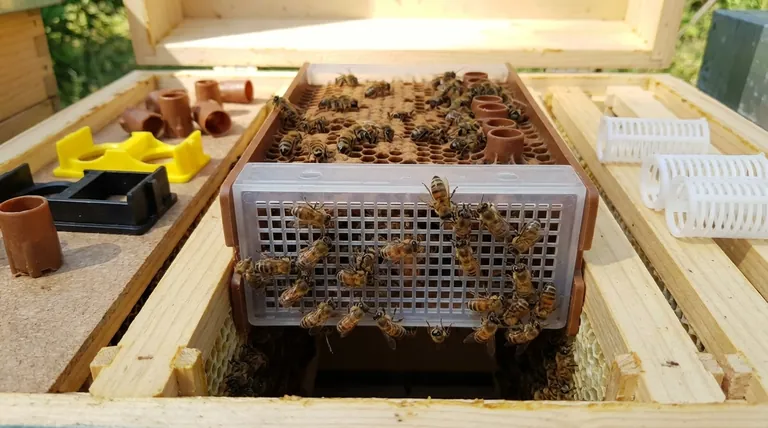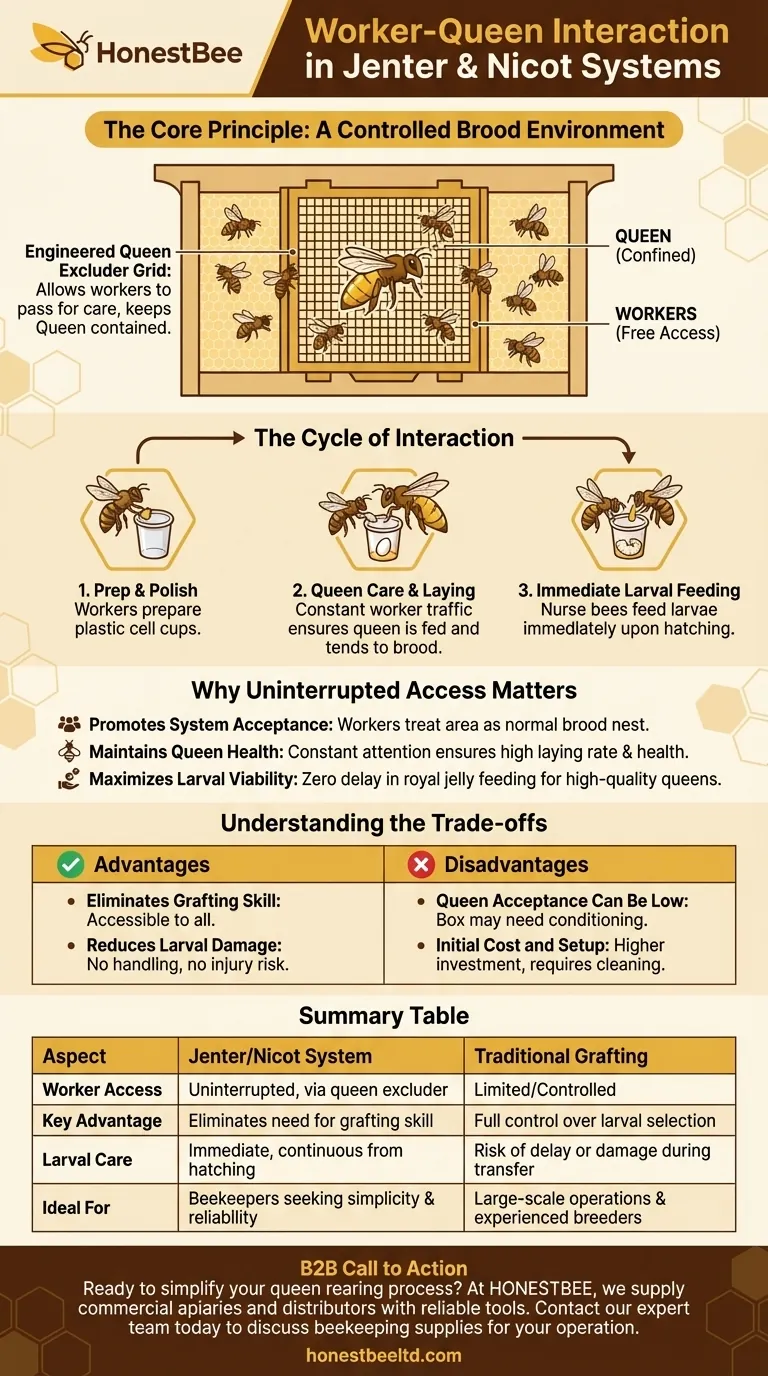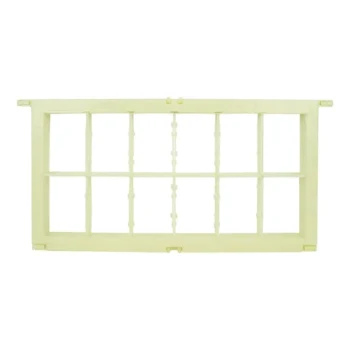In both the Jenter and Nicot queen rearing systems, the design allows worker bees to move freely in and out of the central box where the queen is confined. This is accomplished through a specialized queen excluder grid that forms the face of the box, which is small enough to contain the queen but large enough for workers to pass through to care for her and the brood.
These systems are designed to leverage the colony's natural behaviors. By allowing workers constant access to the queen and newly laid eggs, they eliminate the need for manual grafting while ensuring the young larvae receive immediate and uninterrupted care from nurse bees.

The Core Principle: A Controlled Brood Environment
The Jenter and Nicot systems operate by creating a small, artificial laying environment for the queen that integrates directly into a standard brood frame. The goal is to get the queen to lay eggs in removable plastic cell cups, which can then be used to raise new queens.
How Worker Access is Engineered
The key to the entire system is the front cover of the plastic box. This cover is essentially a small, integrated queen excluder.
The openings in this grid are precisely manufactured. They are large enough for worker bees to pass through without issue but too small for the larger queen to escape.
The Cycle of Interaction
When the system is placed in the hive, workers immediately begin to interact with it. They enter the box to prepare and polish the plastic cell cups, just as they would with natural wax comb.
Once the queen is introduced into the box, this constant traffic of worker bees ensures she is fed and tended to normally. This care encourages her to accept the artificial cells and begin laying eggs.
From Egg to Larva
After the queen lays eggs in the cell cups, worker access remains critical. As soon as the eggs hatch into tiny larvae, nurse bees can enter the box and immediately begin feeding them royal jelly. This removes any delay or shock that can occur with manual grafting.
Why Uninterrupted Worker Access Matters
Allowing workers to freely attend the queen and brood is not just a feature; it is fundamental to the success of these "graft-free" methods.
Promotes System Acceptance
Worker bees are more likely to accept the plastic components and encourage the queen to lay in them if they can treat the area as a normal part of the brood nest.
Maintains Queen Health
A queen's laying rate and health depend on the constant attention of her attendants. The free access model ensures she is never isolated or stressed.
Maximizes Larval Viability
The most significant advantage is the uninterrupted care of the larvae. For a larva to develop into a well-fed, high-quality queen, it must be fed royal jelly from the moment it hatches. These systems ensure there is zero delay.
Understanding the Trade-offs
While effective, these systems are not without their own challenges compared to traditional methods like manual grafting.
Advantage: Eliminates Grafting Skill
The primary benefit is removing the need for good eyesight, a steady hand, and the practice required for successful manual grafting. This makes queen rearing more accessible.
Advantage: Reduces Larval Damage
Larvae are never handled by the beekeeper. They remain in their cells from the moment the egg is laid, eliminating the risk of injury or drying out during a transfer.
Disadvantage: Queen Acceptance Can Be Low
The biggest hurdle is often convincing the queen to lay in the plastic box. Some queens are reluctant, and the box may need to be "conditioned" in the hive or coated with beeswax to improve acceptance.
Disadvantage: Initial Cost and Setup
These kits represent a higher initial financial investment than a simple grafting tool. The components also require careful cleaning and preparation between uses.
Making the Right Choice for Your Goal
Ultimately, the choice between a system like Jenter/Nicot and traditional grafting depends on your specific objectives and skills.
- If your primary focus is simplicity and avoiding delicate larval transfers: The Jenter or Nicot system is an excellent method that automates the egg-laying step for you.
- If your primary focus is scale and absolute control over larval age: Traditional grafting may be more efficient, as it allows you to select larvae of the perfect age from any frame in your apiary without waiting for a queen to lay in a specific apparatus.
By understanding the mechanics of worker interaction, you can confidently select the queen rearing technique that best fits your beekeeping operation.
Summary Table:
| Aspect | Jenter/Nicot System | Traditional Grafting |
|---|---|---|
| Worker Access | Uninterrupted, via queen excluder | Limited/Controlled |
| Key Advantage | Eliminates need for grafting skill | Full control over larval selection |
| Larval Care | Immediate, continuous from hatching | Risk of delay or damage during transfer |
| Ideal For | Beekeepers seeking simplicity & reliability | Large-scale operations & experienced breeders |
Ready to simplify your queen rearing process?
At HONESTBEE, we supply commercial apiaries and beekeeping equipment distributors with the reliable tools needed for successful operations. Whether you're scaling up or improving efficiency, our wholesale-focused solutions provide the quality equipment that supports advanced techniques like the Jenter and Nicot systems.
Contact our expert team today to discuss how our beekeeping supplies can enhance your queen production and overall hive management.
Visual Guide

Related Products
- Nicot Queen Rearing Kit for Beekeeping and Grafting in Nicot System
- Jenter Queen Rearing Kit Complete Set for Bee Breeding
- No Grafting Queen Rearing Kit: System for Royal Jelly Production and Queen Rearing
- Brown Nicot Queen Cell Cups for Breeding Queen Bees Beekeeping
- HONESTBEE Professional Entrance Bee Feeder Hive Nutrition Solution
People Also Ask
- What are the different methods for raising queen bees? Master the Trade-Off Between Simplicity and Control
- What is the Doolittle method of queen rearing? Master Controlled Queen Production for Your Apiary
- What should be done once eggs are present in the comb box? A Guide to Maximizing Queen Rearing Success
- What are the methods of queen rearing? Master Grafting, Direct Lay & More
- What is essential for successful queen rearing in beekeeping? Master Genetics & Boost Your Apiary's Health










